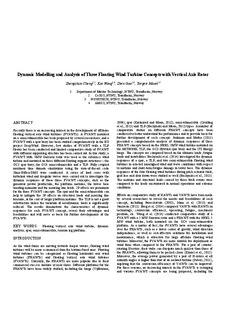Dynamic Modelling and Analysis of Three Floating Wind Turbine Concepts with Vertical Axis Rotor
Chapter
Accepted version
Permanent lenke
http://hdl.handle.net/11250/2391306Utgivelsesdato
2015Metadata
Vis full innførselSamlinger
- Institutt for marin teknikk [3469]
- Publikasjoner fra CRIStin - NTNU [38525]
Originalversjon
ISOPE, ISOPE [Eds.] Proceedings of the twenty-fifth International Ocean and Polar Engineering Conference - ISOPE 2015 p. 415-423 ISOPE - International Offshore and Polar Engineering Conference. Proceedings, International Society of Offshore & Polar Engineers, 2015Sammendrag
Recently there is an increasing interest in the development of offshore floating vertical axis wind turbines (FVAWTs). A FVAWT mounted on a semi-submersible has been proposed by several researchers, and a FVAWT with a spar buoy has been studied comprehensively in the EU project DeepWind. However, few studies of FVAWT with a TLP floater has been conducted and limited comparative study of FVAWT with different supporting structure has been carried out. In this study, a FVAWT with 5MW Darrieus rotor was used as the reference wind turbine and mounted on three different floating support structures – the
OC3 spar buoy, the OC4 semi-submersible and a TLP. Fully coupled nonlinear time domain simulations using the state-of-the-art code Simo-Riflex-DMS were conducted. A series of load cases with turbulent wind and irregular waves were carried out to investigate the dynamic responses of these three FVAWT concepts, such as the generator power production, the platform motions, the tower base bending moments and the mooring line loads. 2P effects are prominent for the three FVAWT concepts. The spar and the semi-submersible can help to mitigate the 2P effects on structural loads and mooring line tensions, at the cost of larger platform motions. The TLP is not a good substructure unless the variation of aerodynamic loads is significantly reduced. The results demonstrate the characteristics of dynamic responses for each FVAWT concept, reveal their advantages and feasibilities and will serve as basis for further developments of the FVAWTs.
